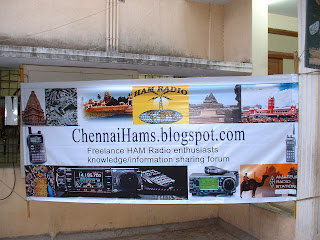
Amateur radio, often called HAM Radio
, is both a hobby and a service in which participants, called "hams," use various types of radio comunications equipment to communicate with other radio amateurs for public service , recreation and self-training. Amateur radio operators / HAMS enjoy personal (and often worldwide) wireless communications with each other and are able to support their communities with emergency and disaster communications if necessary, while increasing their personal knowledge of electronics and radio theory. An estimated six million people throughout the world are regularly involved with amateur radio and its a very addictive passion like photography, adventure sports etc.
Amateur radio or HAM Radio is practised by more than 16,000 licensed users in India. The first amateur radio operator was licensed in 1921, and by the mid-1930s, there were around 20 amateur radio operators in India. Amateur radio operators have played a vital role during disasters and national emergencies such as earthquakes, tsunamis, cyclones, floods, and bomb blasts, by providing voluntary emergency communications in the affected areas.

The first step is to get an
amateur radio license in India from the ministry of communications/Wireless Planning Commission(WPC) . For the same, you have to write and pass an exam, and depending upon the category of license you are applying for, you may also need to learn the morse code. Don't worry that it would be too technical, its simple stuff which you need to learn and within reach of anybody, not essentially only engineers/tech folks.

This examination is held monthly in Delhi, Mumbai, Kolkata and Chennai , every two months in Ahmedabad, Nagpur and Hyderabad, and every four months in some smaller cities, but it all depends on number of applicants . The examination consists of two 50-mark written sections: Radio theory and practice, Regulations; and a practical test consisting of a demonstration of Morse code proficiency in both sending and receiving for Grade I & II. After passing the examination, the candidate must then clear a police verification process . After clearance, the WPC grants the licence along with the user-chosen call sign. This procedure can take up to 12 months.
The catogories of licenses are;i) Advanced Amateur Wireless telegraph Station Licence; You need to know a lot of advanced electronics theory, plus be able to send and receive morse at 15 words per minute. (ii) Amateur Wireless Telegraph Station Licence, Grade - I; Advance electronics theory - and morse at the speed of 15 words per minute. (ii) Amateur Wireless Telegraph Station Licence, Grade - II; A brief theory exam, plus morse at a speed of 5 words per minute. (iii) Restited Grade Amateur Wireless Telegraph Station Licence Only the theory exam and no morse. This restricted licence allows you to use VHF/UHF equipment, that is limited in range to line of sight type of distances, similar to the ones used by police and other services. (iv) Short Wave Listeners' Amateur Wireless Telegraph Station Licence No exams, no morse! You can only listen - you can't talk back, not very exciting really. Who can apply?Only individuals over the age of 18 may apply to become a ham. But even if you are not 18 yet, do not despair. If you are over 12 and can get your parents or guardians to write that you are interested in wireless telegraphy, you can still get a ham radio licence.
For all those interested, the book
"ABC of Amateur Radio and Citizen Band: Authored by Rajesh Verma" is available in Bangalore at below address, alternatively you could send them a DD along with courier charges and they will courier it to you.
EFY Enterprises No:9 , 17th Main 1st Cross,
HAL 2nd Stage, Behind Bajaj Showroom , Indira Nagar , Bangalore - 8 , Tel : 25260394
Cost : Rs.75
Once you are prepared , for taking the exams we may need to apply to the nearest Wireless Planning commission's monitoring station which in Chennai is locate at Perungudi. If there are more than 25 people they would come to any place we decide, else we may need to go there.
Some senior HAMS in Chennai through this free webspace are trying to bring together few interested HAM enthusiasts/SWL as a study group and propose to guide new comers to take up the ASOC exams including conduct weekend classes . Pls spread this messaage among your friends also and all interested people in Chennai Region pls send a mail and register at hamexams@gmail.com. If you would like to watch live as to once you get your India HAM Radio License , how do you setup a basic Ham Radio station and what are the essentials/options for that , visit below link for some good videos , this info is courtesy VU3MES.
http://www.youtube.com/watch?v=2sKwzb7INXs&feature=channelhttp://www.youtube.com/watch?v=YysVmkqAMfo&feature=channelhttp://www.youtube.com/watch?v=3juOZCMDVZQ&feature=channel

















































